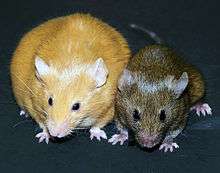Randy Jirtle
Randy Jirtle (born November 9, 1947) is an American biologist noted for his research in epigenetics, the branch of biology that deals with inherited information that does not reside in the nucleotide sequence of DNA.[1] Jirtle retired from Duke University, Durham, NC in 2012. He is Professor of Epigenetics in the Department of Biological Sciences at North Carolina State University, Raleigh, NC, and Senior Visiting Scientist at the McArdle Laboratory of Cancer Research, University of Wisconsin, Madison, WI.[2] Jirtle is noted for his research on genomic imprinting, and for his use of the Agouti mouse model to investigate the effect of environmental agents on the mammalian epigenome and disease susceptibility.
Randy L. Jirtle | |
|---|---|
 Randy Jirtle in 2020 | |
| Born | November 9, 1947 Kewaunee, Wisconsin, U.S. |
| Alma mater | University of Wisconsin-Madison |
| Known for | Evolution of genomic imprinting and identifying imprinted genes. Showing that environmental agents alter the epigenome, thereby affecting health and disease susceptibility in adulthood. |
| Scientific career | |
| Fields | Epigenetics, Genomic imprinting, Radiation biology |
| Institutions | Duke University, University of Wisconsin-Madison, University of Bedfordshire, North Carolina State University, University of Adelaide |
| Website | http://www.geneimprint.com |
Early life and career
Jirtle was born in Kewaunee, Wisconsin. He attended Algoma Public High School and the University of Wisconsin–Madison, graduating with a B.S. degree in nuclear engineering. For graduate school, he remained at the University of Wisconsin-Madison, obtaining an M.S. in Radiation Biology in 1973 and a PhD in 1976 (Major: Radiation Biology; Minor: Statistics). Following post-doctoral studies, Jirtle was appointed Assistant Professor of Radiology at Duke University in 1980, and became Professor of Radiation Oncology in 1990 and Associate Professor of Pathology in 1998. He remained at Duke until 2012, and is currently Professor of Epigenetics in the Department of Biological Sciences at North Carolina State University, Raleigh, NC,[2] and Senior Scientist at the McArdle Laboratory of Cancer Research, University of Wisconsin in Madison, WI.
Research
Jirtle's early research examined the influence of radiation on biological systems. He developed the first in vivo clonogenic assay for hepatocytes,[3] and used it to quantify their survival when exposed to X-rays[4][5] and neutrons.[6] Jirtle also used this clonal assay to study the phenomenon of liver regeneration.[7] These early studies ultimately led to the identification of the insulin-like growth factor receptor (IGF2R) as a human tumor suppressor gene,[8][9] and to studies in the emerging field of genomic imprinting, since murine IGF2R was shown at that time to be imprinted.[10]
In 2003, he provided molecular evidence that maternal dietary supplementation of Agouti viable yellow (Avy) mice with methyl donors (i.e. folic acid, choline, vitamin B12, and betaine) altered the coat color distribution and disease susceptibility in genetically identical offspring by increasing DNA methylation at the Avy locus.[11] [12] A subsequent study[13] showed that the phyto-estrogen, genistein, modifies the fetal epigenome, alters coat color, and protects Agouti offspring from obesity even though it is not capable of donating a methyl group.[14] [15] This article was selected as the ‘Classic Paper of the Year’ in 2011 by Environmental Health Perspectives.[16] It was followed by a study that showed that genistein and methyl donor supplementation can counteract detrimental epigenetic effects induced by a controversial xenobiotic chemical, bisphenol A (BPA).[17] Jirtle used the Avy mouse system to show that embryonic stem cells exposed in vivo to low doses of a physical agent, X-rays, induce positive adaptive responses in the offspring by altering the epigenome, and that these changes are mitigated by antioxidants.[18][19]

He has edited a book on Liver Regeneration and Carcinogenesis,[20] and two books on Environmental Epigenomics in Health and Disease.[21][22] Jirtle is on the Editorial Board of the journals Epigenomics published by Future Medicine, [23] Epigenetics published by Taylor & Francis, [24] and Environmental Epigenetics published by Oxford University Press. [25]
Awards
Jirtle has received a number of awards in recognition of his achievements. He was honored in 2006 with the Distinguished Achievement Award from the College of Engineering at the University of Wisconsin-Madison. [26] In 2007 Jirtle was nominated to be Time Magazine’s Person of the Year by Dr. Nora Volkow, Director of the National Institute on Drug Abuse.[27] He was a featured scientist on the PBS NOVA television program on epigenetics in 2007 entitled Ghost in Your Genes. [28] He was the inaugural recipient of the Epigenetic Medicine Award. [29] In 2009, Jirtle received the STARS Lecture Award in Nutrition and Cancer from the National Cancer Institute [30]. Dr. Jirtle was invited in 2012 to present the NIH Director’s WALS lecture. [31] He received the Linus Pauling Award from the Institute of Functional Medicine in 2014. [32] ShortCutsTV produced a documentary in 2017 based upon Jirtle’s epigenetic research entitled, Are You What Your Mother Ate? The Agouti Mouse Study [33] He received in 2018 the Northern Communities Health Foundation Visiting Professorship Award at University of Adelaide in Australia. [34] Personalized Lifestyle Medicine Institute presented Jirtle with the Research and Innovation Leadership Award in 2019. [35] In 2019, he also received the Alexander Hollaender Award [36] from the Environmental Mutagenesis and Genomics Society stating, “The award recognizes Dr. Jirtle’s discovery that the environment can influence inheritance of phenotypic traits through epigenetic reprogramming representing one of the most important scientific advances of the 21st century.”
References
- Allis, CD, Jenuwein T, Reinberg D, Caparros, M-L (eds.) (2007), Epigenetics, Cold Spring Harbor, New York: Cold Spring Harbor Laboratory Press, ISBN 0879698756
- "Alumnus Randy Jirtle receives 2019 Alexander Hollaender Award" https://www.engr.wisc.edu/alumnus-randy-jirtle-receives-2019-alexander-hollaender-award/ College of Engineering - University of Wisconsin-Madison 1 March 2019
- Jirtle RL, Biles C, Michalopoulos G (1980), "Morphologic and histochemical analysis of hepatocytes transplanted into syngeneic hosts", Am J Pathol 101: 115–126. PMID 6108719
- Jirtle RL, Michalopoulos G, McLain JR, Crowley J (1981), "Transplantation system for determining the clonogenic survival of parenchymal hepatocytes exposed to ionizing radiation", Cancer Res 41: 3512–3518. PMID 7020930
- Jirtle RL, McLain JR, Strom SC, Michalopoulos G (1982), "Repair of radiation damage in noncycling parenchymal hepatocytes", Br J Radiol 55: 847–851. PMID 6753999
- Jirtle RL, Michalopoulos G, Strom SC, DeLuca PM, Gould MN (1984), "The survival of parenchymal hepatocytes irradiated with low and high LET radiation", Br J Cancer Suppl 6: 197–201. PMID 6692410
- Jirtle RL, Michalopoulos G (1982), "Effects of partial hepatectomy on transplanted hepatocytes", Cancer Res. 42: 3000–3004. PMID 7046913
- De Souza AT, Hankins GR, Washington MK, Orton TC, Jirtle RL (1995), "M6P/IGF2R gene is mutated in human hepatocellular carcinomas with loss of heterozygosity", Nat Genet 11: 447–449. PMID 7493029
- Hankins GR, De Souza AT, Bentley RC, Patel MR, Marks JR, Iglehart JD, Jirtle RL (1996), "M6P/IGF2 receptor: a candidate breast tumor suppressor gene", Oncogene 12: 2003–2009. PMID 8649861
- Barlow DP, Stoger R, Herrmann BG, Saito K, Schweifer N (1991), "The mouse insulin-like growth factor type-2 receptor is imprinted and closely linked to the Tme [sic] locus", Nature 349: 84–87. PMID 1845916
- Waterland RA, Jirtle RL (2003), "Transposable elements: targets for early nutritional effects on epigenetic gene regulation", Mol Cell Biol 23: 5293–5300. PMID 12861015
- (https://www.nytimes.com/2003/10/07/science/a-pregnant-mother-s-diet-may-turn-the-genes-around.html
- Dolinoy DC, Weidman JR, Waterland RA, Jirtle RL (2006), "Maternal genistein alters coat color and protects Avy mouse offspring from obesity by modifying the fetal epigenome", Environ Health Perspect 114: 567–572. PMID 16581547
- https://www.sciencedaily.com/releases/2006/03/060329083745.htm
- https://www.washingtonpost.com/wp-dyn/content/article/2007/07/31/AR2007073101030.html
- Tilson HA (2011), "EHP Classic Paper of the Year, 2011", Environ Health Perspect 119: A238. PMID 21628120
- Dolinoy DC, Huang D, Jirtle RL (2007), "Maternal nutrient supplementation counteracts bisphenol A-induced DNA hypomethylation in early development", PNAS 104: 13056–13061. PMID 17670942
- Bernal AJ, Dolinoy DC, Huang D, Skaar DA, Weinhouse C, Jirtle RL (2013), "Adaptive radiation-induced epigenetic alterations mitigated by antioxidants", FASEB J 27: 665–671. PMID 23118028
- "Low Dose Radiation-Induced Epigenetic Alterations Found in Agouti Mouse Model". US Department of Energy. November 8, 2007. Retrieved May 23, 2013.
- Jirtle, RL, ed. (1995), Liver Regeneration and Carcinogenesis: Cellular and Molecular Mechanisms, San Diego: Academic Press, ISBN 012388649X
- Jirtle, RL; Tyson, FL, eds. (2013), Environmental Epigenomics in Health and Disease: Epigenetics and Disease Origins, Heidelberg: Springer, ISBN 978-3642233791
- Jirtle, RL; Tyson, FL, eds. (2013), Environmental Epigenomics in Health and Disease: Epigenetics and Complex Diseases Origins, Heidelberg: Springer, ISBN 978-3642368264
- https://www.futuremedicine.com/journals/epi/editors
- https://www.tandfonline.com/action/journalInformation?show=editorialBoard&journalCode=kepi20
- "Environmental Epigenetics". Environmental Epigenetics Editorial Board. Retrieved April 17, 2015.
- https://www.engr.wisc.edu/2006-distinguished-career-award-randy-jirtle/
- "Person of the Year 2007". Time Magazine. November 8, 2007. Retrieved May 23, 2013.
- https://www.pbs.org/wgbh/nova/genes/
- https://www.opednews.com/populum/page.php?f=NEW-EPIGENETIC-SCIENCE-AWA-by-Meryl-Ann-Butler-080530-226.html
- https://videocast.nih.gov/summary.asp?Live=7781&bhcp=1
- https://videocast.nih.gov/summary.asp?Live=10520&bhcp=1
- https://www.ifm.org/news-insights/randy-jirtle-phd-receives-linus-pauling-award/
- https://www.shortcutstv.com/index-search_results.html?Page=search_results&k=agouti
- https://www.youtube.com/watch?v=Fhrs644pqUc
- http://plminstitute.org/2019-thought-leaders-consortium-schedule/
- https://www.emgs-us.org/blog/emgs-is-proud-to-announce-the-2019-alexander-hollaender-and-emgs-award-recipients